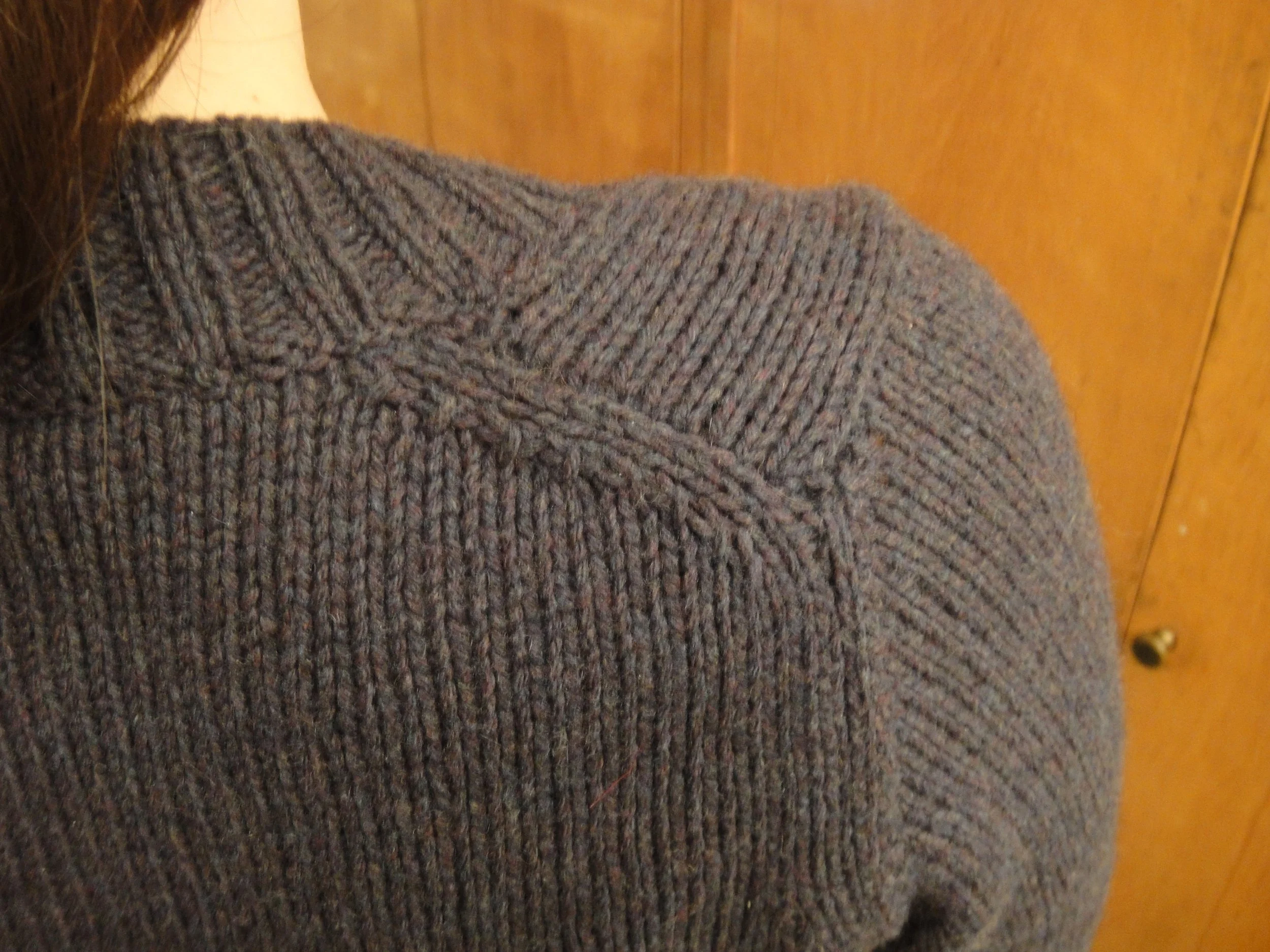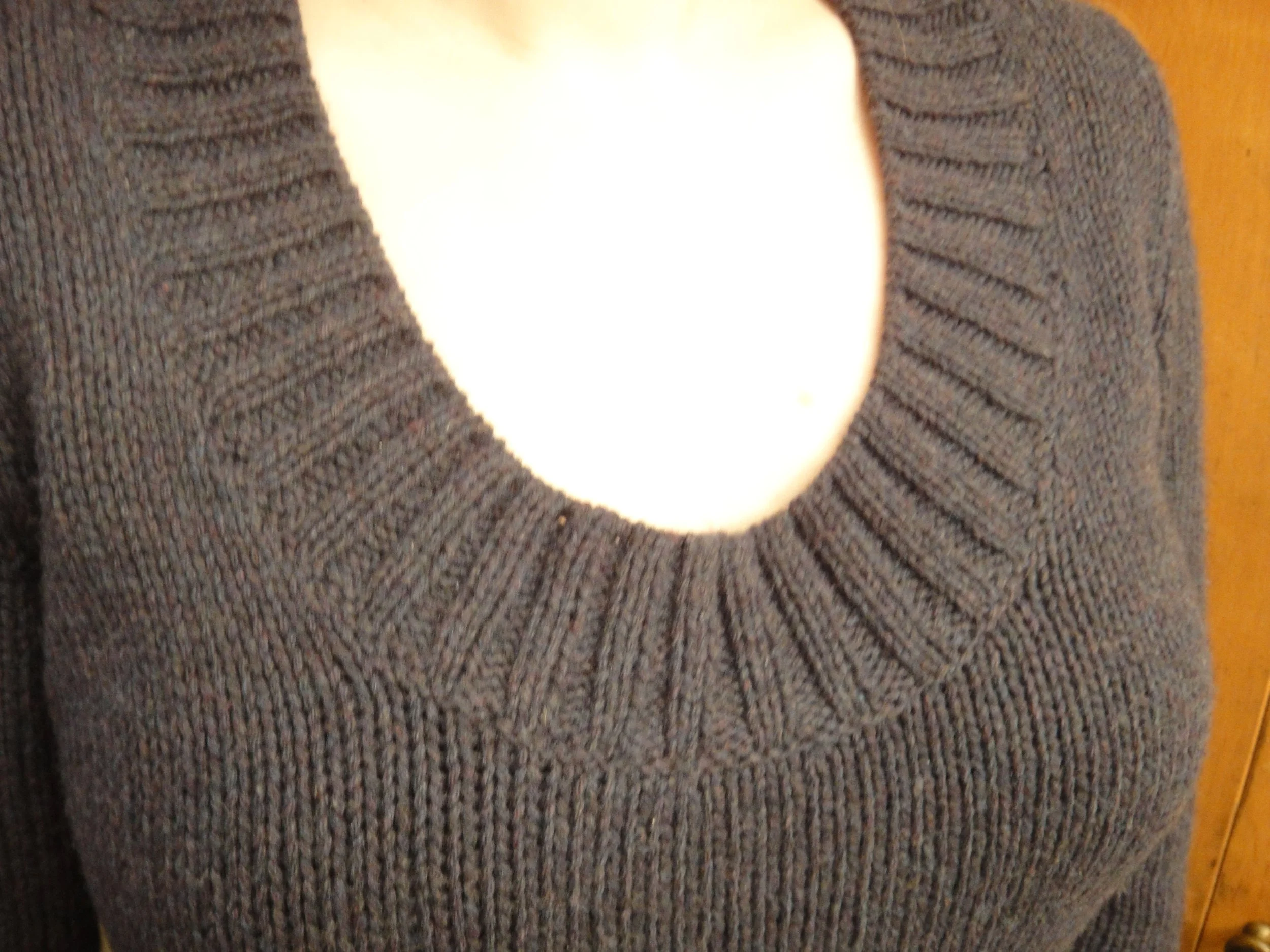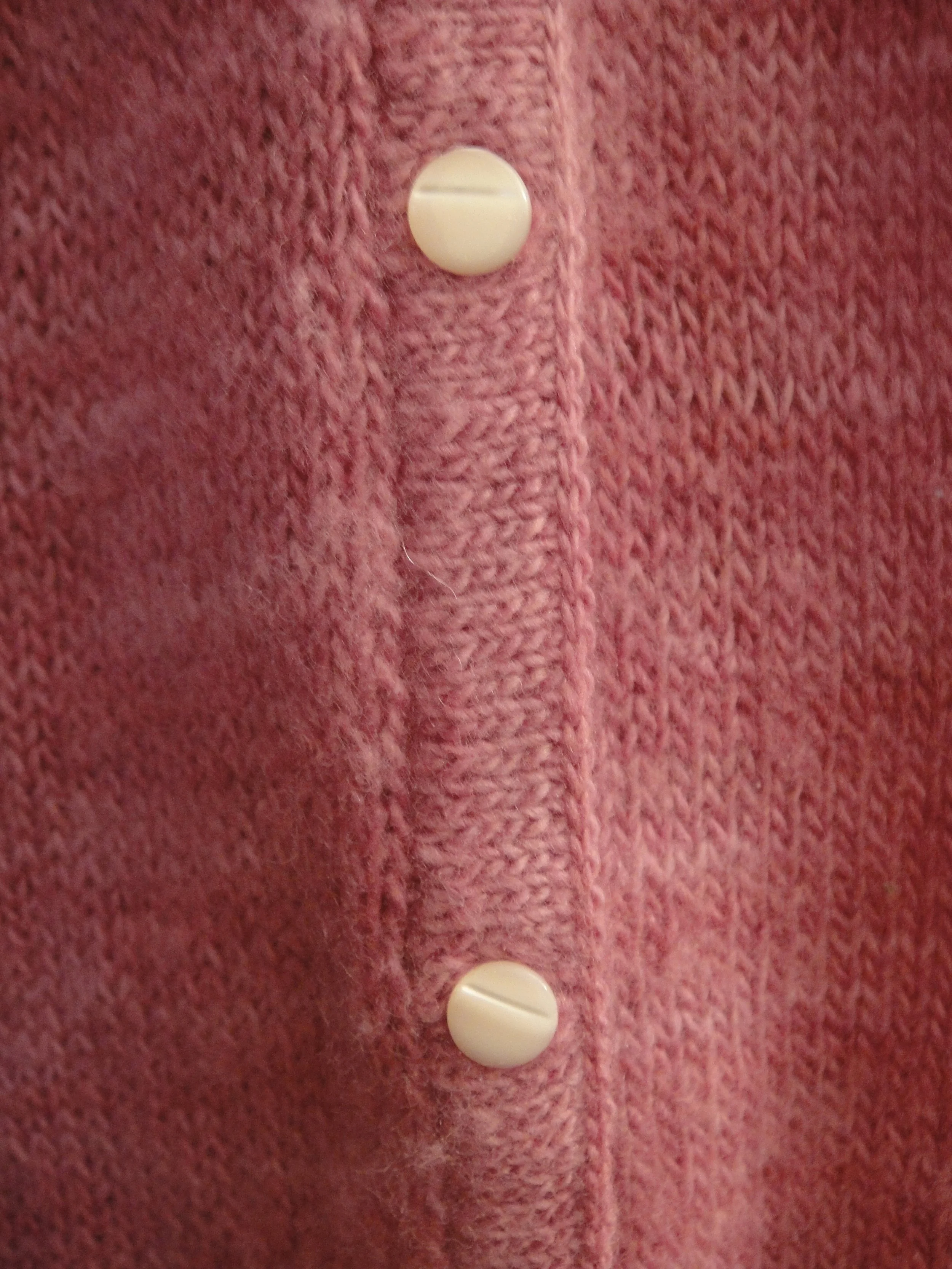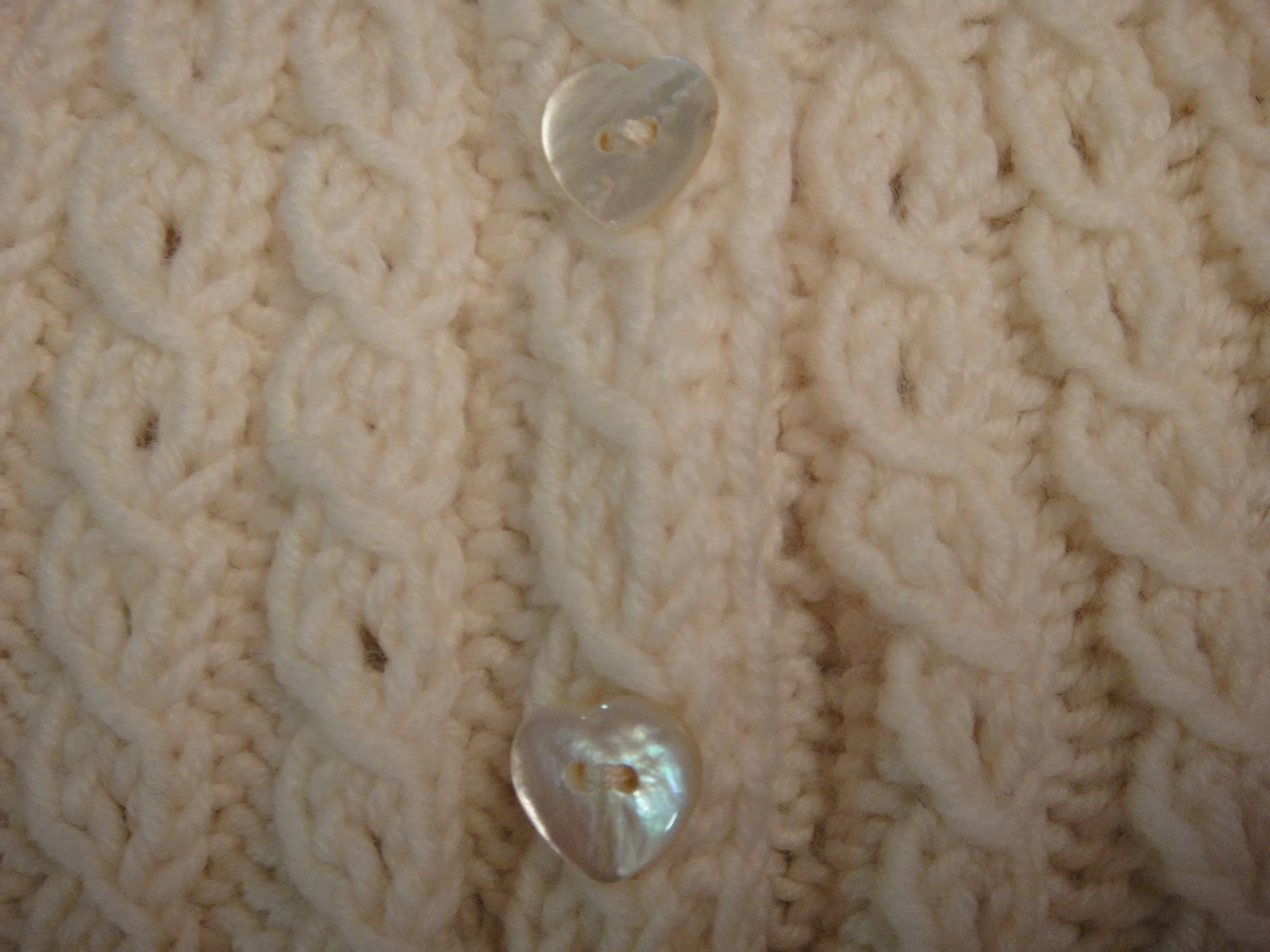It's All In The Details
What are the elements of a knitted garment that contribute to a superior fit? As Catherine Lowe said in one of her fascinating Couture Knitting Classes, a successful garment should draw attention not to itself but to the person wearing it. In other words it should fit you well at all points and should be free of poorly executed areas that might draw the observer’s eye away from your face. This is not to say that you should avoid bright colors or complicated patterns but I think it is sound advice to keep in mind when considering the goals of a garment.
The section of a garment most often discussed in knitwear design books, as being fundamental to achieving a good fit, is the shoulders. Your shoulders are the hanger from which the garment flows and a good fit there is the foundation of successful knit. I am a big fan of full-fashioned shoulder shaping (shown below) which is commonly used in commercial knits. It moves the shoulder seam back from the ridge of the shoulder thus removing bulk from that area and creating a smooth line. The armhole is knit to a length approximately 2 inches short of the shoulder ridge and then decreased with multiple cable decreases, adding a decorative line along the seam. If, like me, you like the structure of sewn shoulder seams but want to create the smoothest line possible, full-fashioned shoulder shaping is an excellent solution. When planning full-fashioned shoulder shaping, first chart the front and back armholes of the garment as if the shoulder seam was located in its normal position and then you can add to the front and decrease from the back length to plan the full-fashioning. For an explanation on how to do this see The Knitter’s Guide to Sweater Design which is an invaluable resource for anyone interested in designing their own sweaters or modifying existing patterns for a better fit. Another trick I use when planning shoulders is to keep the length of the shoulder seam as narrow as possible. This pulls the eye inwards and makes the shoulder area seem narrower.
The neckline of a sweater is another vital area of focus. Remember, we want people to look at your lovely face, not your unsightly neckband. Neckbands can be problematic in many cases because they are picked up from the neckline and then bound off. Some difficulties arise from the trickiness of picking up a correct ratio of stitches and others arise from the sometimes-disheartening shortage of an appropriately neat or stretchy bind off. And if shaping is required within the neckband, this adds still another variable.
I have recently become enamored of the sewn-on ribbed neckband as an antidote to neckband woe. The neckband begins with a cast-on edge (which means you that have some very pretty and stretchable options including the redoubtable tubular cast on) and is then knit to its desired depth and finished by knitting an additional two rows with waste yarn. The edge with the waste yarn, which is admirably pliable, is then pinned to the neckline and back-stitched into place, removing the waste yarn as you go. And fear not, the process of pinning and sewing the neckband is surprisingly stress-free. The back-stitches literally melt into the surrounding stockinette. The result is a neckband that is both strong and flexible, with the crisp, uniform neatness of a cast-on edge framing your neck and the lovely detailing of back-stitch as an outline. For an explanation of sewn on bands and back-stitch, consult The Big Book of Knitting, another excellent compendium of techniques.
Next time we’ll tackle the Knitter’s Holy Grail–Better Buttonbands!
What are the elements of a knitted garment that contribute to a superior fit? As Catherine Lowe said in one of her fascinating Couture Knitting Classes, a successful garment should draw attention not to itself but to the person wearing it. In other words it should fit you well at all points and should be free of poorly executed areas that might draw the observer’s eye away from your face. This is not to say that you should avoid bright colors or complicated patterns but I think it is sound advice to keep in mind when considering the goals of a garment.The section of a garment most often discussed in knitwear design books, as being fundamental to achieving a good fit, is the shoulders. Your shoulders are the hanger from which the garment flows and a good fit there is the foundation of successful knit. I am a big fan of full-fashioned shoulder shaping (shown below) which is commonly used in commercial knits. It moves the shoulder seam back from the ridge of the shoulder thus removing bulk from that area and creating a smooth line. The armhole is knit to a length approximately 2 inches short of the shoulder ridge and then decreased with multiple cable decreases, adding a decorative line along the seam. If, like me, you like the structure of sewn shoulder seams but want to create the smoothest line possible, full-fashioned shoulder shaping is an excellent solution. When planning full-fashioned shoulder shaping, first chart the front and back armholes of the garment as if the shoulder seam was located in its normal position and then you can add to the front and decrease from the back length to plan the full-fashioning. For an explanation on how to do this see The Knitter's Guide to Sweater Design which is an invaluable resource for anyone interested in designing their own sweaters or modifying existing patterns for a better fit. Another trick I use when planning shoulders is to keep the length of the shoulder seam as narrow as possible. This pulls the eye inwards and makes the shoulder area seem narrower.The neckline of a sweater is another vital area of focus. Remember, we want people to look at your lovely face, not your unsightly neckband. Neckbands can be problematic in many cases because they are picked up from the neckline and then bound off. Some difficulties arise from the trickiness of picking up a correct ratio of stitches and others arise from the sometimes-disheartening shortage of an appropriately neat or stretchy bind off. And if shaping is required within the neckband, this adds still another variable.I have recently become enamored of the sewn-on ribbed neckband as an antidote to neckband woe. The neckband begins with a cast-on edge (which means you that have some very pretty and stretchable options including the redoubtable tubular cast on) and is then knit to its desired depth and finished by knitting an additional two rows with waste yarn. The edge with the waste yarn, which is admirably pliable, is then pinned to the neckline and back-stitched into place, removing the waste yarn as you go. And fear not, the process of pinning and sewing the neckband is surprisingly stress-free. The back-stitches literally melt into the surrounding stockinette. The result is a neckband that is both strong and flexible, with the crisp, uniform neatness of a cast-on edge framing your neck and the lovely detailing of back-stitch as an outline. For an explanation of sewn on bands and back-stitch, consult The Big Book of Knitting, another excellent compendium of techniques.Next time we'll tackle the Knitter's Holy Grail--Better Buttonbands!




